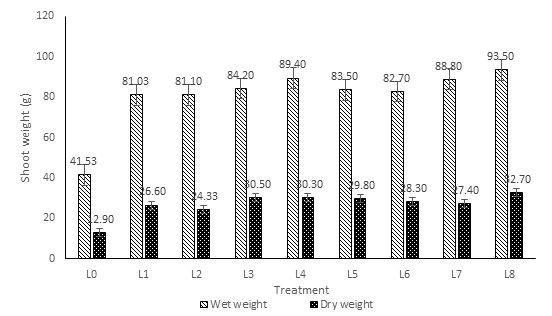
Effect of salted fish waste and cow manure on NPK availability and uptake of lowland rice on peat soil in Pelalawan Riau
Dian Syafitri Ompusunggu(1), Benito Heru Purwanto(2*), Cahyo Wulandari(3), Sri Nuryani Hidayah Utami(4)
(1) Department of Soil Science, Faculty of Agriculture, Universitas Gadjah Mada Jln. Flora, Bulaksumur, Sleman, Yogyakarta 55281
(2) Department of Soil Science, Faculty of Agriculture, Universitas Gadjah Mada Jln. Flora, Bulaksumur, Sleman, Yogyakarta 55281
(3) Department of Soil Science, Faculty of Agriculture, Universitas Gadjah Mada Jln. Flora, Bulaksumur, Sleman, Yogyakarta 55281
(4) Department of Soil Science, Faculty of Agriculture, Universitas Gadjah Mada Jln. Flora, Bulaksumur, Sleman, Yogyakarta 55281
(*) Corresponding Author
Abstract
The low yield of rice in thick peat can be overcome by provisioning complete nutrients. Various efforts have been made to increase the productivity of Indonesian peatlands, one of which is by adding salted fish waste and cow manure. This research was carried out on a plastic house scale from October 2017 to January 15, 2018, in Pelalawan District, Pelalawan Regency, Riau. This research was arranged in a Completely Randomized Design (CRD), consisting of eight treatments, namely L0 = Control, L1 = 1.5 ton.ha-1 of fish waste, L2 = 2.25 ton.ha-1 of fish waste, L3 = 7 tons/ha of cow manure, L4 = 15 ton.ha-1 of cow manure, L5 = 1.5 ton.ha-1 of fish waste + 7 ton.ha-1 of cow manure, L6 = 1.5 ton.ha-1 of fish waste + 15 ton.ha-1 of cow manure, L7 = 2. 25 ton.ha-1 of fish waste + 7 ton.ha-1 of cow manure, and L8 = 2.25 ton.ha-1 of fish waste + 15 ton.ha-1 of cow manure. The results showed that the application of cow manure and salted fish waste could increase soil pH, total NPK, and NPK uptake. The application of 2.25 tons/ha of fish waste and 15 tons/ha of cow manure resulted the best results in soil pH, total NPK, and NPK uptake, therefore it is recommended for the cultivation of lowland rice on peat soil.
Keywords
Full Text:
PDFReferences
Agus, F. and I. G. M. Subiksa. 2008. Peatlands: Potential for Agriculture and Environmental Aspects. 1th ed., Soil Research Center and World Agroforestry Center (ICRAF). Bogor
Cramer G.R. 2002. Response of abscisic acid mutants of Arabidopsis to salinity. Funct. Plant
Biol. 29:561 – 67.
Istomo. 2006. Evaluation and adjustment of the silvicultural system of peat swamp forests, especially ramin species (Gonystylus bancanus (Miq.) Kurz.) In Indonesia. 1th ed., Proceedings of the National Workshop on Alternative Policies in the Preservation and Use of Ramin.. Bogor
Krueger, J.P., J.Leifeld, S.Glatzel, S.Szidat, C. Alewell. 2015.Biogeochemical indicatorsof peatland degradation—a case study of a temperate bog in northern Germany. Bio-geosciences., 12: 2861–2871.
Leiwakabessy F. M and A.Sutandi..2004. Fertilizers and fertilizers. 2th ed., Department of Land Faculty of Agriculture Bogor Agricultural University. Bogor.
Miller, R.H ., and R .L .Donahue.1990. An introduction to soil and plantgrowth .1th ed. Printice Hall Inc . Englewood Cliffs, NJ.
Ministry of Maritime Affairs and Fisheries. 2005. Utilization of Fish Waste as Organic Fertilizer Raw Materials. https://kkp.go.id/djpb.
Munns, R., M. Tester., 2008. Mechanisms of salinity tolerance. Annu. Rev. Plant Biol.
59: 651–681.
Mokolobate, M.S. and R.J. Haynes, 2002. Increases in ph and soluble salts influence the effect that additions of organic residues have on concentrations of exchangeable and soil solution aluminium. European J. Soil Sci., 53:481-489.
Najiyati, S., A. Asmana., I.N.N. Suryadiputra. 2005. Community empowerment on peatlands. 13th ed Wetlands Intl.-Indonesia Prog. and Wildlife Habitat Canada. Bogor
Radjagukguk, B. 1997. Sustainable agriculture on environmentally friendly peatlands In Natural. Environmentally Friendly Peat Management. 2th ed., BPP Technology. Jakarta.
Radjagukguk, B. 2000. Changing the physical and chemical properties of peat soil due to peat land reclamation for agriculture. Journal of Soil and Environmental Sciences, 1: 1-15.
Ratmini, S. 2012. Characteristics and management of peat land for agricultural development. Suboptimal Land Journal, 12: 197-206.
Salsi, I. 2011. Characterization of peat with various ameliorant materials and their effects on physical and chemical properties to support the productivity of peatlands. Agrovigor Journal, 14: 42-50.
Salisbury. 1995. Plant physiology . 2nd ed., ITB, Bandung.
Sarief, E. S., 1986. Agricultural sciences. 8th ed., Library Buana, Bandung.
Setyamidjaja, Djoehana. 1986. Fertilizers and fertilizers. 1th ed., Simplex, Jakarta.
Surya, R.E., Suryono. 2013. Effect of composting on the ratio of C / N of animal manure and available NPK nutrient levels and soil cation exchange capacity. UNESA Journal of Chemistry 2: 137-144
Wong, M.T.F., S Nortcliff., and sudah R.S., Swift, 1998. Method for determining the acid ameliorating capacity of residue compost, urban waste compost, farm yard manure and peat applied to tropical soils. Communications in Soil Science and Plant Analysis, 29: 2927-2937.
Article Metrics
Refbacks
- There are currently no refbacks.
Ilmu Pertanian (Agricultural Science) ISSN 0126-4214 (print), ISSN 2527-7162 (online) is published by Faculty of Agriculture Universitas Gadjah Mada collaboration with Perhimpunan Sarjana Pertanian Indonesia (PISPI) and licensed under a Creative Commons Attribution-ShareAlike 4.0 International License.













